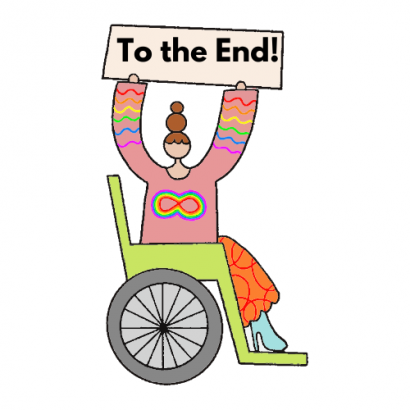It costs too much to design for and execute on accessibility, they say.
Yes, they say that designing web spaces to ensure that the 1 billion people on planet earth with disabilities can engage in and contribute to cyberspace costs too much.
Think about it.
Where’s the ROI?
Adding ramps to buildings that would otherwise not have them is an extra cost. Never mind that those with no mobility limitations may sneak up a ramp or two at times.
And when it comes to digital media and technologies, is all this necessary?
Who needs larger fonts, clear audio-visuals, contrast between the words on the screen and the background? Squint! It’s like looking through a pinhole; you get less light in and it increases your focus. It’s not like those who have 20/20 vision ever increase font size or zoom in to get a better view.
And as for voice controls “implemented for users with physical impairments,” per The Business Case for Accessibility article, they may not be so necessary. I mean who really wants to talk to the Siris and Alexas of the world all day.
So that’s what they say and why they say it.
It’s way too costly to design for inclusivity.
You don’t benefit? Really?
But wait, how many people need a wheelchair or cane to move from place to place permanently or even temporarily? Try getting on the NYC subway, up and down the stairs, with just a cane; see how that makes you feel. You start to avoid certain stations altogether which can make commuting complex. Trust me. I’ve been there. It wasn’t pretty.
The “I didn’t get that. Could you try again,” answer from Siri can be pretty tiresome but voice control surely can be convenient.
And how many people have 20:20 vision? Certainly not I and certainly not as one gets older.
So, embedding inclusivity in design processes is not critical? That’s hogwash. Yes, I said it. Nonsensical hogwash. Please excuse me while I commit pleonasm.
When it comes to designing physical products, services, and spaces for inclusivity, the question is why not? We all benefit from these supposed extras, don’t we?
One Step Forward, No Steps Back, All the Way to the End!

As the world shifts to cyberspaces, we cannot leave those who may have a physical, speech, visual, neurological, cognitive, and/or auditory disabilities behind. Can we?
Ensuring accessibility should be something done from the get-go.
The readings for this week reminded me of my days of ensuring computer hardware was designed for repairability. It took being part of the product development teams day-in-day-out to shift the narrative. From that experience, I can say that organizations with separate teams (i.e., the Barclays Accessibility team discussed in “The Business Case for Digital Accessibility”) focused on accessibility is a start but they must go all the way.
El Gibbs in the article about taking the rules we have offline into online worlds might even agree that these separate teams must be allowed to greatly influence the approach taken by “designers” and eventually become extinct; if not, this expectation might always remain a “fringe idea.” Frankly, the design-for-accessibility perspective should be socialized in all education systems, from PK-12 to higher education when it comes to learning how to problem-solve for humanity.
I mean, how much more would it cost to add a line of code that supports accessibility so that even more people are reached?
A photographer spending a few seconds including alt text to describe their images would certainly make it easier for search engines to find them; after all, as David Berman, in his video on why we should care about accessibility reminds us that search engines don’t have eyes!
Now, I have to ask for a friend.
How do organizations tout having diverse teams when some persons with disabilities may not be able to access all the tools needed for their full participation? Where are all the employment lawyers? If public spaces must adhere to ADA guidelines, shouldn’t cyberspace?
Design Thinking, Take Charge!
I am with Elise Roy on an idea she speaks of during her TEDTalk on how designing for accessibility benefits all: design thinking enables solutions to be realized through keen observation and prototyping so why not seek its counsel often and include multiple perspectives when problem-solving? Couldn’t one say that it is wasteful to offer goats and chickens to those who cannot hear without providing a solution to keep those animals safe? Why weren’t they part of the solution?
Could it be that maximizing accessibility decreases waste somewhere? Just saying.
Still disagree?
Not sure where to start?
Jennifer Allen gives a quick and useful starting list in tomesguide.com on how to make your website more accessible. If you prefer a video to help you, Nicole Sauk has some helpful tips; watch from the 3rd minute in. Please, check these out!

